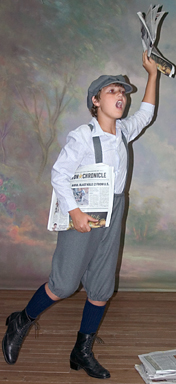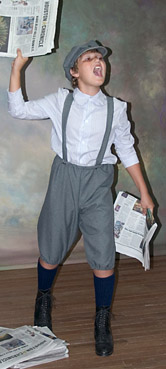Newsboy – The Creative Process

September 27th-October 3rd, 2004
Sculptor Bridgette Mongeon has documented the entire process of creating a figurine of a newsboy and a life-size bronze sculpture. Watch the artist work through these posts. In this blog, she has also included information for students and teachers. In the previous post, we watched her sew a vintage pattern for knickers.
If you are lost and want to go back to the chronological running list of posts, follow this link.
ARTICLE
This months Houston Tribune has an article about the newsboy sculpture written by yours truly. It was fun article to write, because I was able to recall my experience as a papergirl.
Happy National Newspaper week—October 3-9
International Newspaper Carrier Day—October 9th
You can read a little about National Newspaper week and Newspaper Carrier Day on the web. You might also want to learn how to fold a pressman’s hat out of newspaper.
In 1960 the International Circulation Managers Association developed a Newspaper Carriers’ hall of fame. It is now run through Newspapers Association of America. You can see a list of the inductees at this web site. I checked out the list of the inductees. It was interesting to see who was a newspaper boy or girl. The inductees that interested me were: “Red” Skelton, a comedian that I use to watch when I was a child (incidentally, he is my favorite); John Wayne, who starred in so many western movies that he has become part of the history of westerns on television (I loved watching the old westerns); and Dr. Norman Vincent Peale, I have read several of his books, and I just love them. But, these inductees are not the only newspaper carriers from history, just the ones inducted into this hall of fame.

THIS WEEK’S WORK
I have not sculpted on the newsboy all week. I am still waiting for my reference photos. I did purchase material for the pattern that is coming from Vintage Pattern Lending Library (VPLL). The anticipation of getting to work on both the small sculpture and the large one is almost more than I can bear. However, I have noticed that the waiting is a part of the creative process.
Over the years, scientists have categorized the creative process into 5 sections—first insight, saturation, incubation, illumination, and implementation. There is a lot of information on this on the web. It is a fascinating subject.
As the last few weeks of these journals have shown, I have been in the saturation stage, and now I enter the incubation stage. I find incubation important for sculpting, because when I do finally get to the activity of sculpting I am energized. I am sure many will see that the actual sculpting, once begun, will go extremely fast. I will work with fervor and a great deal of passion. I am not sure how, but when everything is in place somehow that passion transfers to the clay.
While I wait, I still think about Dusty. I think about his twist, the way his legs were, how his ears stuck out over his hat, and many other nuances. I have determined the newsboy cap is not correct in the preliminary photos and I have found a pattern to make a different cap as well.
I have also spent time trying to inform teachers, students, and homeschoolers about this website. Using this web site as an educational tool has done a great deal to increase my passion for the sculpture. The newsboy represents so much more now; he represents the education and increased self-esteem of young people.
It is Friday evening and I just spoke with Janyce Engan, one of the owners at the VPLL. The patterns are on their way! Unfortunately they are in a size 8 and I need a 12. So Janyce suggested I call Amazon Dry Goods. This company has a small booklet on how to size up patterns. I think I can do it on my own but have decided to order this helpful pamphlet. Amazon Dry Goods is a wonderful resource. They also have catalogues of old patterns but more than that they have catalogues of accessories, parasols, hats, shoes etc. They also have toys and games, including paper dolls (I loved paper dolls). It is a great resource to have for period costumes.
While I had Janyce on the phone I just couldn’t help but ask her more questions about clothing throughout history. I asked her the question I posed a few weeks ago. Why did the ladies’ patterns have a waist of 26? She reminded me that a girl wore a corset from the age of 10 or 11 and continued to do so throughout their life. These bound the waist. She said she even has one pattern where the waist is 26 and the hips are 44.
Janyce said VPLL has 5,000 patterns from 1840-1949. Their customers are theater people, antique car collectors (who want to dress in the time period of their car), ballroom dancers, docents for museums, and many others.
I asked her about the boys clothing. She reminded me that for the first few years of life boys were dressed like girls. As the boys aged their length of pants was an indication of maturity. She pointed out that in the production of The Music Man, which was set in 1912, there is a song titled “You Got Trouble”, with a line that says “the minute your son leaves the house does he rebuckle his knickerbockers below the knee?” Boys wanted their knickers long to show that they were grown up, so they would buckle them below the knee.
For a little more of history…
Patterns came into existence in about 1860. James McCalls and Ebenezer Butterick began producing patterns around 1867. The sewing machine could only be afforded by the wealthy; so most garments were made by hand. I asked Janyce if the markings on the pattern would be confusing. She said VPLL scans in the patterns. They are not changed at all; however, the verbiage is upgraded to terms that someone who has knowledge of patterns would understand. For example Plait is an old form of the language for pleat.
I have toyed with the idea of sending these patterns off to a seamstress when they arrive; however, I do want to have creative input in their creation, and I think that this will most likely happen by my taking control of the sewing.
Now that we have learned about the creative process, let’s move on to the next blog that documents the process about Sculpting Tricks and More Research.
STUDENTS AND TEACHERS
• Read the article that I wrote about being a paper girl. What was I trying to save money for?
• In the history of the sewing machine, who was the first person to receive a patent on the sewing machine?
• In the 1850’s Isaac Singer built the first commercially successful sewing machine. Have you ever seen the name Singer on a sewing machine?
• Why did Elias Howe sue Isaac Singer? Did he win the lawsuit?
• Walter Hunt invented the safety pin. Do you know what else he built?
